
Hi,
The lecture this week focuses on ‘Finding the Gaps’ and begins by asking a variety or practitioners the following questions:
• Q1 – What would you like to be doing that you are not doing in your work?
• Q2 – How important are side projects, and are you currently working on any?
In response to the first question, Simon Manchipp from SomeOne explains that there isn’t anything else he would want to be doing. He is the Managing Director of a successful, transnational company which are able to pick and chose from the most interesting briefs around.
What’s interesting about this is that you’re changing your mindset, you’re changing the way you think and you’re changing to adapt to each of these client’s demands and that’s really exciting, really interesting. Simon Manchipp, SomeOne
Sam Winston relishes in a world where he feels responsible for, not only the culture and society around him, but also for creating culture and influencing the society his work is seen in. It’s this ‘influence’ which makes him passionate about his work.
The men from Regular Practice have an interesting viewpoint on this question. It feels like they have two strands to their thinking. One is to fulfill the brief of the client and the other is to research and look for things they like. Eventually these two stands will cross over and they will use the things they ‘like’ to fulfil clients briefs.
Adrian Talbot and Julian House from Intro talk about a time when maybe the design world was becoming a bit intense or repetitive for them and how they ventured into side projects to give them, “a new lease of life”.

So onto question two then – How important are side projects, and are you currently working on any?
I think Simon from SomeOne has made a career out of the side hustle. Isn’t that how most businesses start? Testing the water with a couple of jobs on the side before diving in and going freelance?
Sam Winston is similar in that regard, however, he talks about, “find[ing] something that isn’t what you do.” He likes to find some solitude which allows him the space to find answers to other aspects of his life.
I think this is what a side hustle is all about. It gives you creative freedom in a world where you might not always be in control. Don’t like the client or brief? Don’t do the work. Simple.
By taking on these side hustles it allows you to find, explore and discover new ways of working which, ultimately, will benefit other aspects of your life too.
In listening to Regular Practice’s response, it made me think about how a side hustle sits as a thought process. Work is work – it’s a job you do to put food on the table. It’s not always interesting or exciting but needs to be done. The side hustle pays homage to the fact that designers love to create. It exists in a place free from societal constraints, where if it succeeds or fails will not be judged. It’s almost like a hobby where designers can find a world of freedom which enables and extends the creative process.
In Regular Practice’s case, they are interested in “authorship” and how they can create something which is 100% their doing. It’s a way in which they describe enhancing and formulating their identity.
House and Talbot from Intro both followed their interest, music and type respectively, to create this energy and excitement which is needed by creatives to reinvigorate their passions and ideas. I like this notion of designers becoming a bit tunnel visioned and needing a break from the norm to widen their view, develop and learn. This in turn can then be applied back at the day job.
Resources
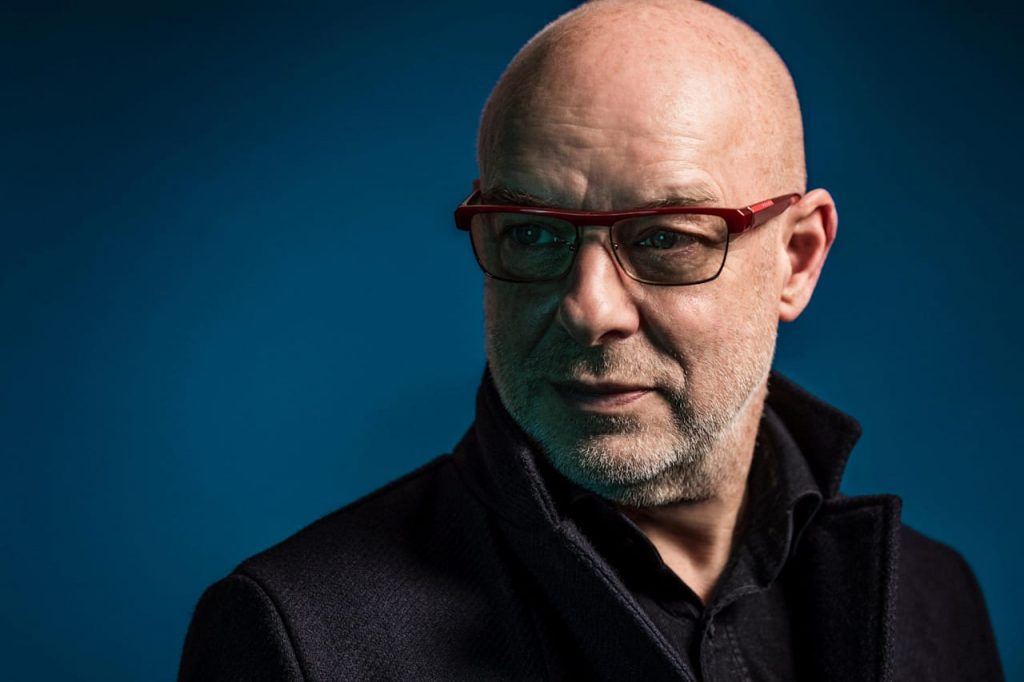
Brian Eno talks about beating the creative block:
Having a side hustle and using it to reinvigorate your creativeness is an excellent approach. Unfortunately, its not always viable with tight deadlines and multiple projects. Brian Uno talks about ways in which he beats the creative block. I particularly like the ‘Oblique Strategies’ cards he has developed and found the following website:
The first 5 strategies that came up were:
- What is the simplest answer?
- Use unqualified people
- Look at a very small object, look at its centre
- Do something boring
- Use an old idea
The Human Condition
It has always felt to me that the negative aspects of my life need to be hidden from the outside world. Remembering that we are part of a human race and are all fallible makes for a more empathetic and understanding planet.
From a school age it becomes a priority to disguise your vulnerabilities and to fit in within a ‘societal norm’. However, these insecurities are a shared experience and by opening yourself and showing these vulnerabilities you may earn respect and a new sense of connection. When I think of my closest friends, they know more about my ‘inside idiot’ than anyone and yet continue to be my friends.
To err is human, to forgive divine, Alexander Pope
I also used to be overwhelmed by this desire for everything to be perfect and exactly how I imagined it in my head. Over time this feeling has slowly abated and by doing my best each time I was able to learn, develop and grow. Things still don’t always turn out as expected. but you know what? That’s OK. I am on a journey to greatness and will keep on going.
Workshop Challenge
What skills do you have? What skills do you need?
- Write a list of your skills and a list of skills / ways of working / thinking / or area of knowledge you wish to develop
- Create a design which summarises a process model that works for you at the moment, highlighting the skills you have and the gaps you have.
- This piece of work needs to communicate your process model. It could be a diagram, a 3D statement that clearly communicates a thought process relevant to you at this moment (how you deal with weaker skill gaps and how you maximise your talents), a statement, a model, a tool.
Upload to the ideas wall a link to your blog demonstrating further reflection.
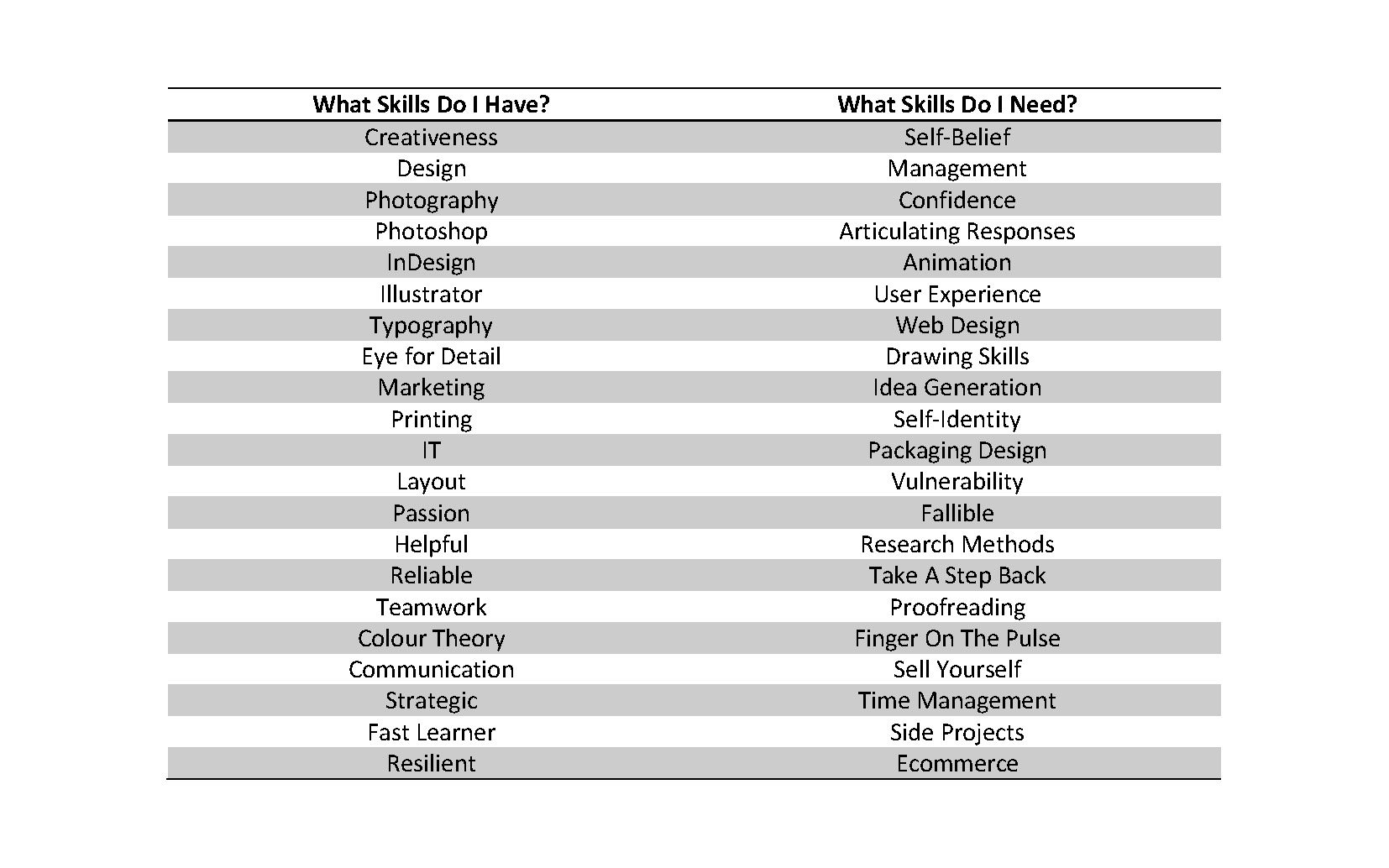
The process of filling in the above table was actually quite cathartic. It shows how far I have come but also how far there is to go and how this process will be continually evolving.

My initial ideas was to create a road map of the journey of the brie with key points as symbols.
For example: Roundabouts, to symbolise going round and round. Or a beach area to symbolise a relaxation period.
I am hoping to animate in some way too. Maybe a car visiting all the places in its journey to the outcome…..probably a breakdown or two.
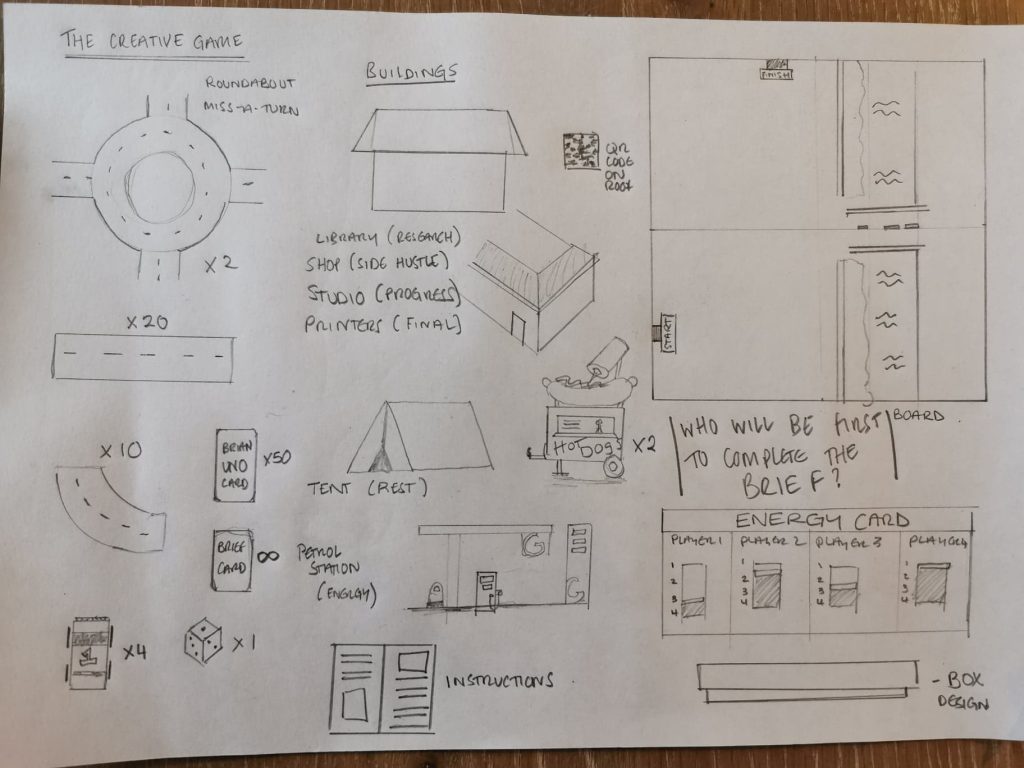
Following on from this week’s crit it was suggested I turn this idea into a board game of sorts where you have track and can set out your own journey. I developed the above as a contents list for the box and it took on a life of its own. This was great fun!
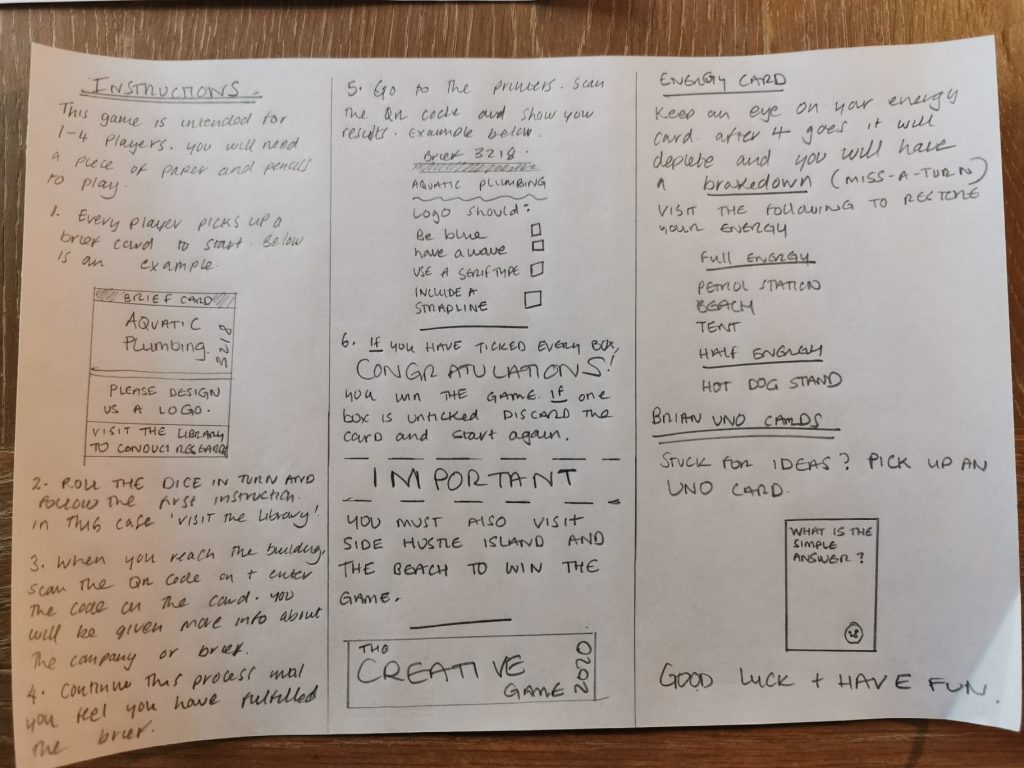
I wanted the actual game to be playable so wrote up these instructions for it. The inclusion of QR codes makes it more dynamic and more life like. There are many gaps in knowledge when starting a brief and this game highlights this by encouraging you to research and learn.
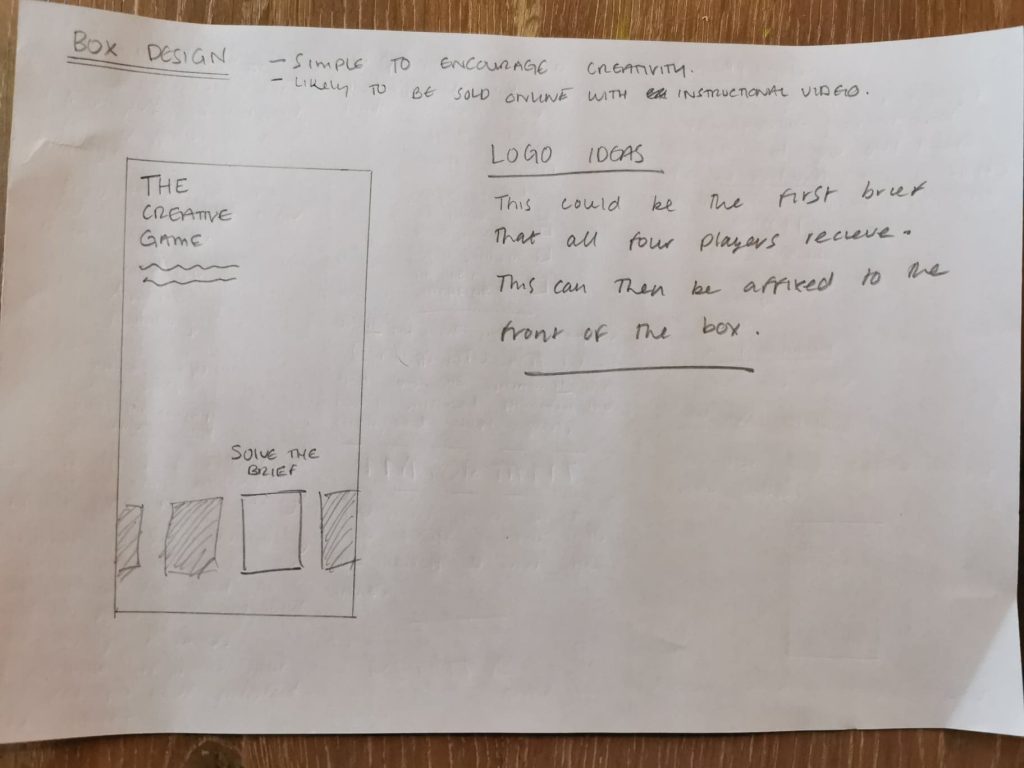
I wanted to make the box really simple. The purpose of the game is to encourage creativity from the players so by keeping it simple it doesn’t influence their ideas.
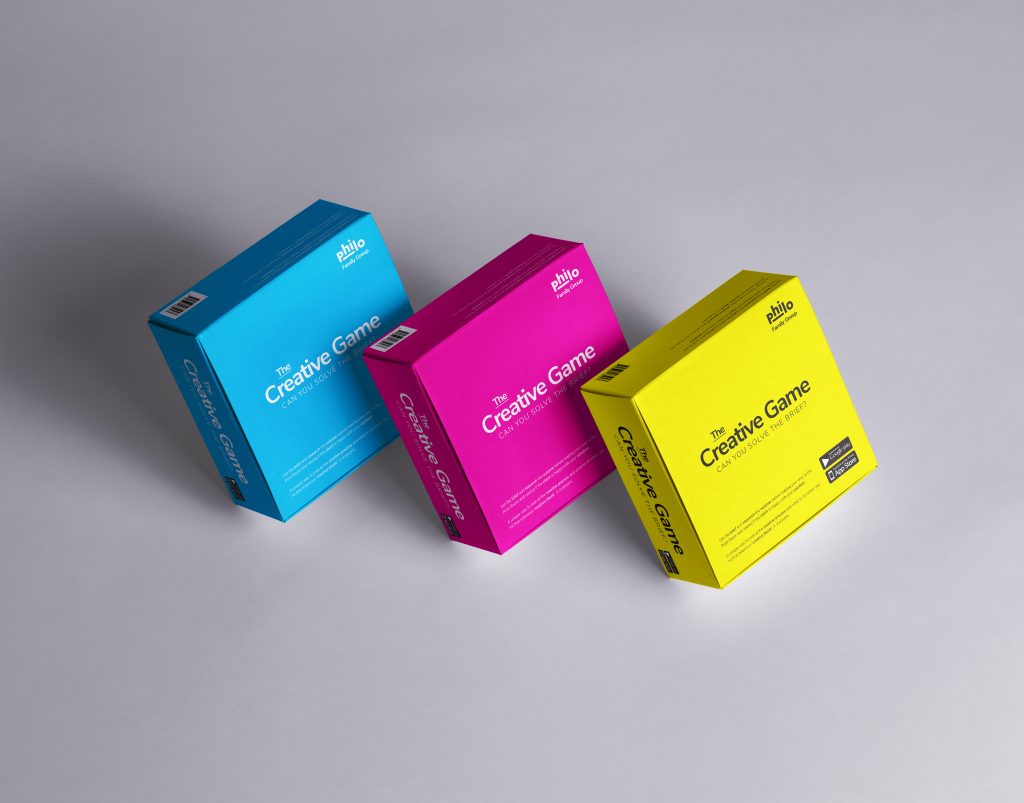
I started with the design for the box and continued the simple idea through to the actual game contents to ensure consistency.
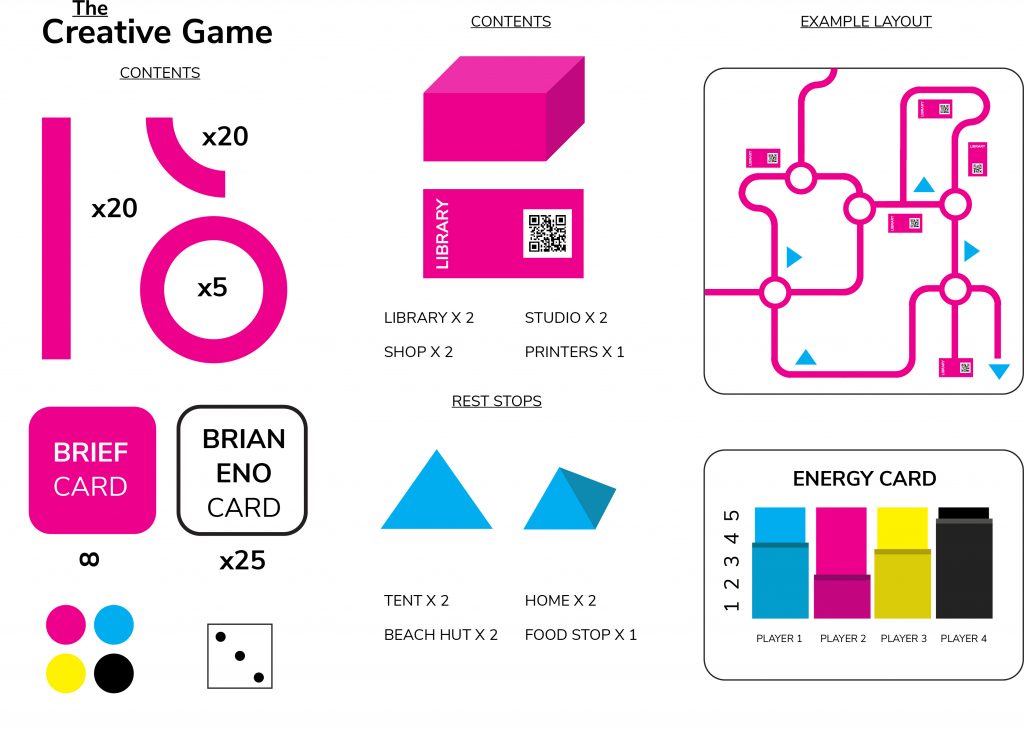
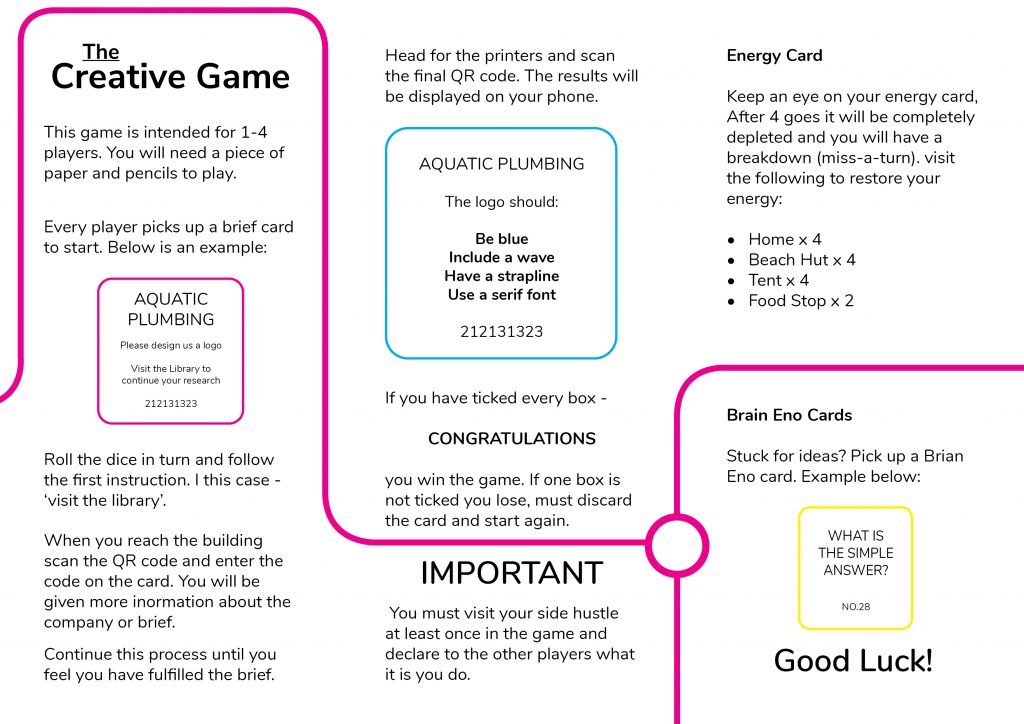
The Ideas Wall
Personal Reflection
In response to this week’s lecture questions, I would love to be taking on more freelance or self initiated work. All of my work at the moment is from my day job and while it’s excellent in providing a creative outlet, it can be a bit restrictive in the outcomes. As an example, I am limited in the colours I can use because of the political parties which are associated with them.
Unfortunately, I have been told by work that I am not allowed to take on any side projects as the department I am working with are trying to commercialise and this is seen as a conflict of interest. Having said that, this week has taught me the importance of a side hustle. It can reinvigorate creativeness and teach you new skills which can be applied in the regular job.
As my day job is moving towards commercialising it is filled with an exciting opportunity to take on a wider variety of jobs. I suppose the ultimate goal would be to exist in a world like Simon Manchipp and pick and choose jobs while earning a substantial income…..ahh….one day?
Brian Eno’s take on the creative block really resonated with me this week. Sometimes, when working on job after job with little variety the work can become a bit stagnant. By taking a step back, relaxing or looking at it from a different perspective you are able to create a spark which may lead to a new idea.
I also really like the life lessons of the ‘school of life videos’. We are all fallible and that’s ok. When I started my working life I wanted everything to be perfect and nothing less was acceptable. I feel that as I have got older I have learnt that being human is a trait we share. In acknowledging this and sharing my failings / learnings I have gained the respect of my colleagues and peers.
The workshop challenge this week has been a bit of a journey in itself. My initial ideas have changed considerably and the final piece developed into a sleek representation of the life of a creative.
I hope the biggest take away from the workshop challenge is that the road to a successful solution is constantly changing. You are the master of your own destiny and, if motivated, can find the skills, knowledge and resources to remain resilient and as effective as possible.
Life is all about balance and creativeness is not an exception. By finding the time to breath and experience, the creative process becomes exciting and fun and that road, relatively simple.
References
Brian Eno (2017, April 5). How to Beat Creative Block. Available at Brian Eno: How To Beat Creative Block – BBC Click (Links to an external site.)
Brian Eno (2017, April 5). On Creative Potential. Available at Brian Eno On Creative Potential (Links to an external site.)
The School of Life (2017, September 21). The Importance of Vulnerability Available at The Importance of Vulnerability (Links to an external site.)
The School of Life (2015, March 23). Keep Going. Available at Keep Going (Links to an external site.)
Brian Eno, Oblique Strategies (last ed, 2018), [Accessed 16 January 2019] Available from https://en.wikipedia.org/wiki/Oblique_Strategies (Links to an external site.)

Leave a Reply